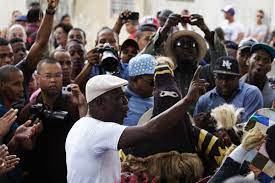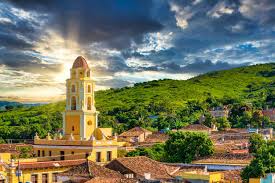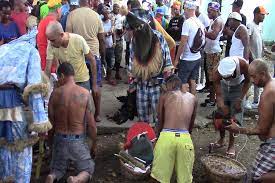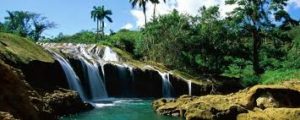LA SOCIEDAD SECRETA ABAKUÁ EN CUBA, UNICA EXISTENTE EN EL CONTINENTE AMERICANO. PHOTOS.
La Sociedad Secreta Abakuá, o Ñañiguismo, es una fraternidad iniciática o sociedad secreta de hombres afrocubanos, que se originó a partir de asociaciones fraternales en la región de Cross River en el sureste de Nigeria y el suroeste de Camerún.
Abakuá ha sido descrito como “una versión afrocubana de la masonería” la única de su tipo existente en el continente americano. Ñáñigo es el nombre que reciben sus miembros.
La sociedad abakuá cubana es heredera y depositaria de las tradiciones asociativas masculinas del Calabar, en los actuales territorios de Nigeria sudoriental y Camerún sudoccidental. Su presencia en Cuba es resultado de la trata trasatlántica de africanos esclavizados durante la época colonial y fue reconstruida en diversas zonas portuarias de Cuba como La Habana, Matanzas y Cárdenas. Su organización y contenido tiene como base una leyenda africana que narra la historia de la violación de un secreto por una mujer: la princesa Sikán encuentra al pez sagrado Tanze y reproduce su bramido en el tambor sagrado Eku.
Sus miembros, tanto africanos, como criollos y cubanos, fueron perseguidos y acosados debido al desconocimiento histórico de las autoridades coloniales y neocoloniales sobre el papel que desempeñan las diversas formas asociativas según la pertenencia de género y como vehículo de control social y transmisión de valores culturales entre sus miembros, donde resaltan la cosmovisión religiosa, las artes y ceremonias, los espacios y recintos para los ritos, la pintura corporal y de otros objetos y sitios identificados como sagrados.
VIDEOS- SOCIEDAD ABAKUA EN CUBA…
Esta asociación surgió en las primeras décadas del siglo XIX en los momentos de mayor hostilidad hacia el esclavo y el negro quienes, ante el acoso, sólo hallaron un medio apropiado para evadir la represión: una agrupación mutualista bajo la expresión más desarrollada de su conciencia social, la religiosa.
La primera sociedad de blancos se fundó a principios del presente siglo y llevó el nombre de Akanarán Efó Muñón Ekobio Mucarán. Su creador fue Andrés Facundo de los Dolores Petit (1829-1878), célebre también por sus aportes a la Regla de Palo con la elaboración del cuerpo conceptual y ritual de la variante Kimbisa y influyó en la diseminación de esta asociación entre otras personas nacidas en Cuba y poseedoras de los más disímiles oficios, ocupaciones y creencias religiosas. En este sentido, por su condición inclusiva, la sociedad abakuá es un cimero ejemplo del ejercicio del antirracismo y la inclusión social.
El Ñañiguismo no puede desvincularse de las creencias africanas acerca de la influencia que ejercen los antepasados (espíritus), por lo que en todas sus ceremonias religiosas se les convoca para garantizar el desarrollo del acto ritual, según rigurosas normas litúrgicas. La representación simbólica es el Ireme o diablito.
PARTICIPACION DE LA SOCIEDAD ABAKUA HISTORICAMENTE…
Sus miembros han participado en diversos hechos históricos relacionados con el origen y formación de la nación cubana como la protección al General Antonio Maceo en el barrio de San Isidro durante su presencia clandestina en La Habana; el intento de rescatar a los ocho estudiantes de medicina en 1871 antes que se cometiera uno de los crímenes políticos más horrendos en la historia de Cuba; el apoyo financiero a José Martí durante sus campañas de organización en Tampa y Cayo Hueso para lo que el propio Héroe Nacional de Cuba denominó La guerra necesaria de 1895 y, consecuentemente, en la participación en la contienda independentista, entre otros acontecimientos.
Sus expresiones musicales y danzarias han influido fuertemente en diversas manifestaciones de la rumba, la conga, el danzón y el son cubanos, que pueden sintetizarse en muy destacados cultores y compositores, miembros de la sociedad abakuá, como Chano Pozo, Santos Ramírez, Miguel Faílde e Ignacio Piñeiro, respectivamente; de igual manera, sus expresiones lingüísticas relacionadas con el efik, también han influido en el habla popular urbana de la zona occidental de la Isla y han trascendido a la literatura en obras de Alejo Carpentier y Manuel Cofiño, por ejemplo. Valga señalar también la muy estimada figura de Jesús Orta Ruiz, el Indio Naborí, hermano abakuá que con su poesía llenó un amplio espacio de la décima cubana.
Por tales motivos, diversos estudiosos de la cultura cubana como Fernando Ortiz, Lydia Cabrera y Argeliers León —por solo aludir a tres muy destacados— han resaltado los diversos valores que representa un sostenido legado patrimonial de la nación.
Las actividades de culto se realizan todas en templos, de los cuales existen 40 entre las provincias de Ciudad de La Habana y Matanzas, distribuidos en los municipios de Guanabacoa (14), Marianao (11), Regla (6), San Miguel del Padrón (4), Cárdenas (4) y Ciudad de Matanzas (1).
SOCIEDAD ABAKUA Y SUS RITOS…
En todos los ritos se utilizan trazos o grafías llamados Ekeniyó, que constituyen un sistema ideográfico de señales para inmovilizar y fijar las representaciones de hechos globales. Tales símbolos se trazan con yeso amarillo y blanco y comprenden tres categorías, los Gandos, las Firmas o Anaforuanas y los Sellos.
Los Gandos representan situaciones complejas del ceremonial, se trazan en el suelo y sobre ellos se colocan diferentes objetos del culto y se sitúan los dirigentes religiosos (Plazas).
Las Firmas o Anaforuanas representan a cada una de las jerarquías que integran la estructura de los abakuá y cumplen una función consagratoria cuando se trazan sobre determinados elementos del ritual.
Los sellos son la representación o identificación de cada juego o potencia abakuá, de los que existen 123 en toda Cuba.
En la actualidad, los abakuá poseen órganos de coordinación municipal en los municipios de Cárdenas, Matanzas, Guanabacoa, Regla, Marianao y San Miguel del Padrón, y dos a nivel provincial en Ciudad de La Habana y Matanzas, encargados todos de controlar la obediencia a los reglamentos y principios de la sociedad.
Dentro del ñañiguismo se reconocen varias jerarquías. El Indisime es el aspirante a entrar en una potencia, mientras el Obonekué es un hombre ya iniciado. Plaza es una jerarquía vitalicia que ocupa un puesto relevante dentro del juego y está encargado de preservar y hacer cumplir las normas y principios rituales y sociales. Títulos de Plazas son Iyamba, Mokongo, Ekueñón, Nkrikamo, Nasako y otros.
ABAKUÁ SECRET SOCIETY IN CUBA IS THE ONLY ONE EXISTING IN THE AMERICA CONTINENT. PHOTOS.
The Abakuá Secret Society, or Ñañiguismo, is an initiation fraternity or secret society of Afro-Cuban men, originating from fraternal associations in the Cross River region of southeast Nigeria and southwest Cameroon.
Abakuá has been described as “an Afro-Cuban version of Freemasonry,” the only one of its kind existing on the American continent. Ñáñigo is the name given to its members.
The Cuban Abakuá society is the heir and depositary of the male associative traditions of Calabar, in the current territories of south-eastern Nigeria and south-west Cameroon. Its presence in Cuba is the result of the transatlantic trade in enslaved Africans during the colonial era and was rebuilt in various port areas of Cuba such as Havana, Matanzas, and Cárdenas. Its organization and content is based on an African legend that narrates the story of the violation of a secret by a woman: Princess Sikán finds the sacred fish Tanze and reproduces her bellowing on the sacred Eku drum.
Its members, both African, Creole, and Cuban, were persecuted and harassed due to the historical ignorance of the colonial and neocolonial authorities about the role played by the various associative forms according to gender belonging and as a vehicle for social control and transmission of cultural values. among its members, where the religious worldview, arts and ceremonies, spaces and venues for rites, body painting, and other objects and sites identified as sacred stand out.
VIDEOS- YORUBA- ANDABO- CONGO SONGS….
This association arose in the first decades of the 19th century at times of greatest hostility towards slaves and blacks who, faced with harassment, only found an appropriate means to evade repression: a mutualist group under the most developed expression of their social conscience. , the religious
The first white society was founded at the beginning of this century and took the name of Akanarán Efó Muñón Ekobio Mucarán. Its creator was Andrés Facundo de los Dolores Petit (1829-1878), also famous for his contributions to the Regla de Palo with the elaboration of the conceptual and ritual body of the Kimbisa variant and influenced the dissemination of this association among other people born in Cuba and holders of the most dissimilar trades, occupations and religious beliefs. In this sense, due to its inclusive condition, the Abakuá society is a prime example of anti-racism and social inclusion.
Ñañiguismo cannot be separated from African beliefs about the influence exercised by ancestors (spirits), which is why they are summoned in all their religious ceremonies to guarantee the development of the ritual act, according to rigorous liturgical norms. The symbolic representation is the Ireme or devil.
PARTICIPATION OF THE ABAKUA SOCIETY HISTORICALLY…
Its members have participated in various historical events related to the origin and formation of the Cuban nation, such as the protection of General Antonio Maceo in the San Isidro neighborhood during his clandestine presence in Havana; the attempt to rescue the eight medical students in 1871 before one of the most horrendous political crimes in Cuban history was committed; the financial support to José Martí during his organization campaigns in Tampa and Key West for what the National Hero of Cuba himself called The Necessary War of 1895 and, consequently, in the participation in the independence struggle, among other events.
His musical and dance expressions have strongly influenced various manifestations of the rumba, the conga, the danzón and the Cuban son, which can be synthesized in very prominent cultists and composers, members of the Abakuá society, such as Chano Pozo, Santos Ramírez, Miguel Faílde and Ignacio Piñeiro, respectively; In the same way, their linguistic expressions related to Efik have also influenced popular urban speech in the western part of the Island and have transcended to literature in works by Alejo Carpentier and Manuel Cofiño, for example. It is also worth noting the highly esteemed figure of Jesús Orta Ruiz, the Naborí Indian, Abakuá brother who with his poetry filled a wide space of the Cuban tenth.
For these reasons, various scholars of Cuban culture such as Fernando Ortiz, Lydia Cabrera and Argeliers León —just to mention three very prominent ones— have highlighted the various values that a sustained patrimonial legacy of the nation represents.
The cult activities are all carried out in temples, of which there are 40 between the provinces of Havana City and Matanzas, distributed in the municipalities of Guanabacoa (14), Marianao (11), Regla (6), San Miguel del Padrón (4), Cárdenas (4) and the City of Matanzas (1).
ABAKUA SOCIETY AND ITS RITES…
In all the rites, strokes or spellings called Ekeniyó are used, which constitute an ideographic system of signals to immobilize and fix the representations of global facts. Such symbols are traced with yellow and white plaster and comprise three categories, the Gandos, the Signatures or Anaforuanas, and the Seals.
The Gandos represent complex ceremonial situations, they are traced on the ground and different cult objects are placed on them and the religious leaders (Plazas) are located.
The Signatures or Anaforuanas represent each one of the hierarchies that make up the structure of the Abakuá and fulfill a consecratory function when they are drawn on certain elements of the ritual.
The seals are the representation or identification of each Abakuá game or power, of which there are 123 in all of Cuba.
Currently, the Abakuá have municipal coordination bodies in the municipalities of Cárdenas, Matanzas, Guanabacoa, Regla, Marianao, and San Miguel del Padrón, and two at the provincial level in the City of Havana and Matanzas, all in charge of controlling obedience to the regulations and principles of the company.
Within ñañiguismo several hierarchies are recognized. The Indisime is the aspirant to become a power, while the Obonekué is a man already initiated. Plaza is a life hierarchy that occupies an important position within the game and is in charge of preserving and enforcing ritual and social norms and principles. Plaza titles are Iyamba, Mokongo, Ekueñón, Nkrikamo, Nasako, and others.
Agencies/ Wiki/ Jiribilla/ SociedadAbakuaHist./ Extractos/ Excerpts/ Internet Photos/ Arnoldo Varona/ www.TheCubanHistory.com
THE CUBAN HISTORY, HOLLYWOOD.



 ABAKUÁ SECRET SOCIETY in Cuba, the only one existing in the American Continent. PHOTOS. * LA SOCIEDAD SECRETA ABAKUÁ en Cuba, única existente en el Continente Americano. PHOTOS. VIDEOS.
ABAKUÁ SECRET SOCIETY in Cuba, the only one existing in the American Continent. PHOTOS. * LA SOCIEDAD SECRETA ABAKUÁ en Cuba, única existente en el Continente Americano. PHOTOS. VIDEOS.








